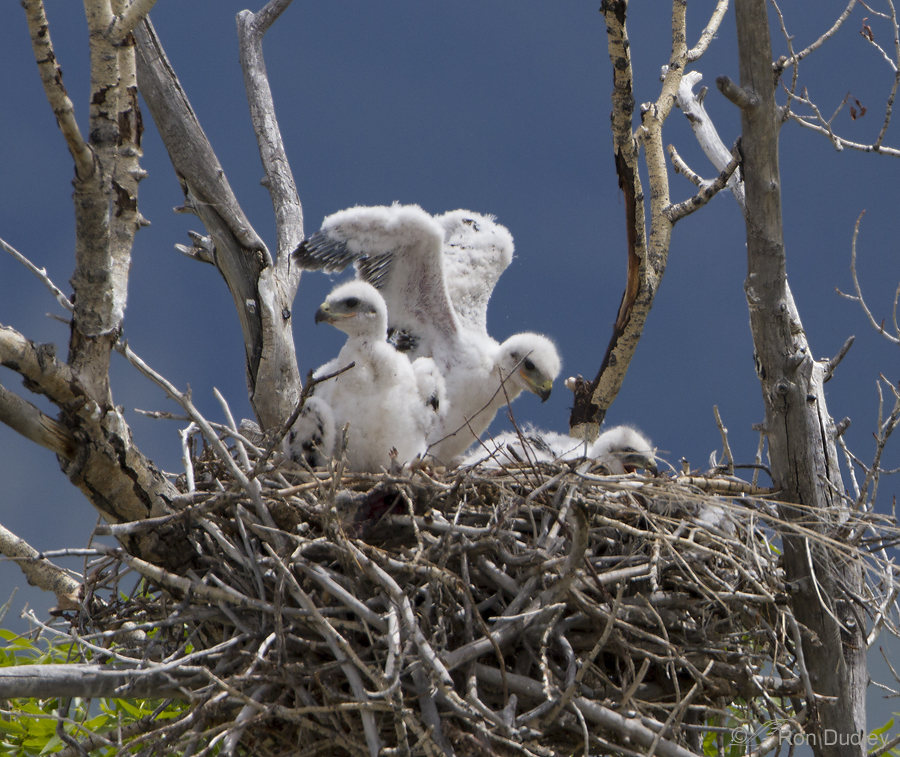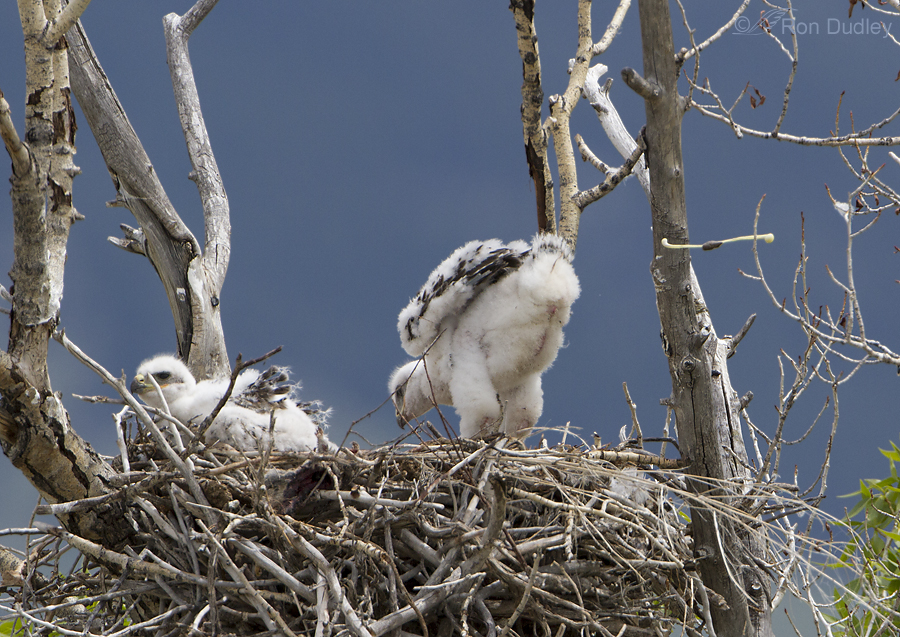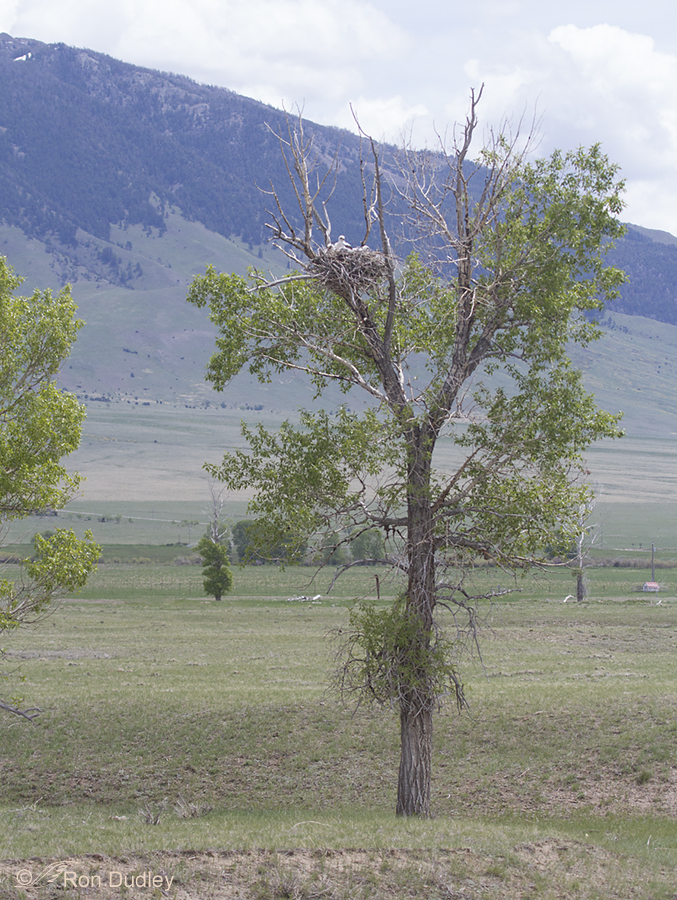Last week I posted images of a Ferruginous Hawk nest with chicks in Montana. I actually photographed two of them. These chicks were slightly older than those in my first post. A very long drive was required to get to this nest so the images were taken at mid-day and the light was harsh and there’s no light in the eyes of the birds.
This nest was very close to a major highway which surprised me. Ferruginous Hawks are known to be extremely shy when nesting but this pair had obviously become completely acclimated to the constant traffic and highway noise. I photographed the nest from the side of the road (in the barrow pit, actually) and never exited my pickup. The birds weren’t disturbed in the least by my presence. In fact, one of the adults spent the entire time perched on the top of a power pole alongside the road within about 30 feet of my pickup. I had to look almost straight up to see it.
The other adult was at the nest only briefly and spent most of its time perched in a nearby Cottonwood tree. There were at least three chicks – all seemingly healthy and active.
They spent most of their time sleeping, yawning and stretching.
And pooping. At this age the chicks seemed fastidious about nest sanitation by defecating over the nest edge. It was both endearing and tense to watch the wobbly chick slowly and very carefully turn around and back up to the edge of the nest prior to doing its duty. Here one of the chicks finally got close enough and…
let fly. You can see the excreta in the air behind the bird (at first glance it may appear to be a tree twig).
Watching this happen made me wonder how often unstable chicks fall out of the nest while defecating – especially when the wind’s blowing (as it often is in Montana).
This is the nest tree. The image was taken at 100mm which should give you an idea of how close the nest was to the highway – very unusual for Ferruginous Hawks in my experience. I would never approach a Ferrug nest this closely in an isolated area where the birds haven’t been acclimated to human activity.
Ron
Note: I’m on the road again and will be for much of the week. I’ll have no computer access on this trip so I won’t be able to respond to any comments that may be made (though I do get them via phone email and enjoy reading them while I’m in the field).







That first one is a winner of the apparently proud parent with its young.I think of boys when they are around ten and they would love this. Great shots, both yours and the hawks. they are so cute and you bring to me the sight of the family at a young age that I have never seen and I really appreciate that.The wider shot of the tree shows the beauty of the area and the vulnerability of these hawks, too.
WOW WOW WOW!!! These are fantastic, thank you so much for SHARING!!!
A very special set of photos. After watching our young kestrels, who are flying very well now, dealing with the effects of wind, I would imagine that the edge of the nest would be a very precarious position for birds who are clearly too young to fly. I love the kinds of things you see when you watch birds (or other animals) closely.
Thank you, thank you, thank you.
I love baby hawks!! Those litle feet that stick out are adorable! Thanks Ron.
That’s some real world stuff there Ron! Working with hawks, its a way of judging thier health as much as thier manners. When on the fist, my hawk Sakura will search the area, hunting, rarely making eye contact with me. But when its time to slice (flacons tend to drop, hawks will shoot with cannon fire, lol) She will look at me and begin to bow…and fire away. She has never taken aim at me! As far as falling from the nest, I’m sure it happens. Its not unheard of for parent birds to take care of thier young while on the ground.
Tim
Oh how wonderful! Thanks for making the trip and for sharing the most fantastic shots with us!
Charlotte
Thank you for this wonderful peek into the lives of other creatures. These birds are so beautiful, and I hope they remain safe and happy.
Love the pictures!! And the last one – its so beautiful I keep coming back and looking at it. It looks so peaceful and tranquil although I’m sure it I was really there as I imagine, I wouldn’t be relaxing – I’d be worried that the chicks were going to fall out of the nest!
The tree looks like a Cottonwood…it says, “There’s water nearby”. One of my favorite trees, a HUGE, VERY OLD Cottonwood, a real grandfather tree, stands next to MouseCreek in Wounded Knee. When a breeze blows, it sounds like rushing water, like a waterfall…a cooling sound on a hot day. How I would love to hear the stories that old tree could tell! ( Interesting how horses love to eat Cottonwood bark.) Have a good, safe trip…good light, lots of cooperative subjects…with light in their eyes, of course, and very little of the human kind.
Beautiful shots,,,the first, especially, is a real gem…love the little guy with foot raised giving you the peace sign. As usual, the comments are so much appreciated. Many birds (most? all?) defecate over the side of the nest , if possible…and apparently it can be a risky business..never thought of that before….especially on a windy day. Now you’ve got me wondering how often this what causes them to be found on the ground. We’ve placed birds back into their nest at times, when possible… and when the parents have seemed concerned that the baby is on the ground, especially when we know a predator is around. Timing is vital so the parents aren’t even more upset by our actions. We’ve also seen Robins adopt an orphaned. abandoned or “lost” chick other than their own.
Great shor by the chick and by you, Ron.
Enjoy your trip and again thanks for starting my day with a laugh.